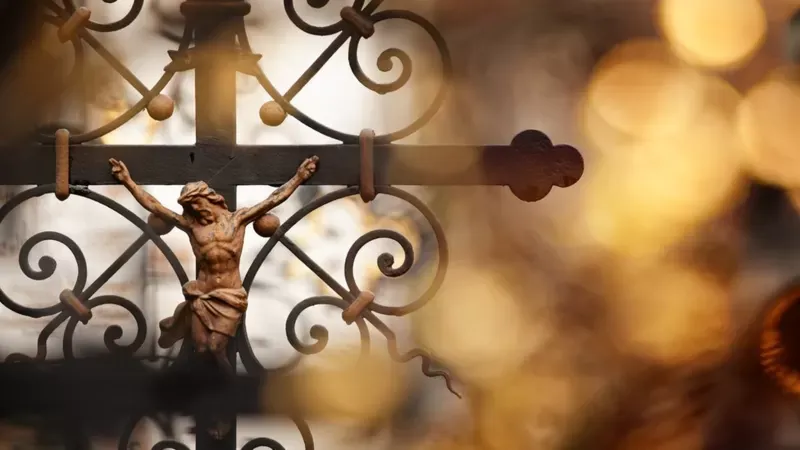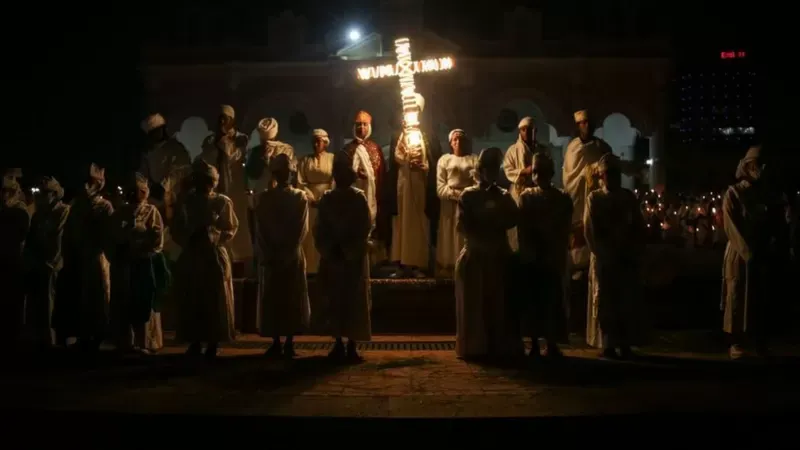According to the story on which Christians base their beliefs, Jesus of Nazareth was crucified by order of the then Roman prefect in Judea, Pontius Pilate, and his transition to that death – a series of episodes known as the Passion – is one of the elements plants that are commemorated in the Holy Week.
So central was the crucifixion in the history of Christianity that the cross eventually became the symbol of religions that profess devotion to the figure of Jesus Christ.
LOOK: Easter: why do the dates change every year? (and how Christian and Jewish Passover differ)
But what happened to that cross where his death occurred?
Dozens of monasteries and churches around the world say they have at least one piece of the so-called “true cross” on their altars, to the praise of their faithful.
And many of them base the veracity of the origin of their relics on 3rd and 4th century textswhich narrate the finding in Jerusalem of the precise piece of wood where Jesus Christ was executed by the Romans.
“That story, which includes the Roman Emperor Constantine and his mother, Helena, was the initiator of this story of the cross of Christ, which has survived to this day,” Candida Moss, professor of History of the Gospels, explained to BBC Mundo. and Early Christianity at the University of Birmingham.
It is based on the writings of ancient historians such as Gelasio de Cesarea or Jacobo de la Vorágine. But for many of today’s historians, they do not determine the authenticity of the pieces of wood that we see today in various temples around the world – nor can they serve as confirmation of their provenance.
“Very likely that piece of wood is not the cross where Jesus was crucified, because many things could have happened with that piece of wood. For example, that the Romans have reused it for another crucifixion, in another place and with other people, “says Moss.
But then, why did the story of the “true cross” arise and why are there so many pieces that are supposedly part of the “big tree”?
“(Because of) the desire to have a physical closeness with something we believe,” Mark Goodacre, historian and expert on New Testament issues at Duke University, in the United States, responds to BBC Mundo. “Christian relics are more a wish than something true.”
the golden legend
In the Gospel narrative, after Jesus died on the cross, his body was taken to a tomb in what is now the Old City of Jerusalem.
And for almost 300 years there was no mention in the Christian story of that piece of wood.
It was around the fourth century that it is believed that the bishop and historian Gelasius of Caesarea published an account in his book “The History of the Church” about the discovery in Jerusalem of the “true cross” by Helena, a saint of the Catholic Church. and, moreover, the mother of the Roman Emperor Constantine, who imposed Christianity as the official religion of the Empire.
The story, which is referenced by other historians and by writers such as Jacobo de Vorágine in his “golden legend” of the thirteenth century, indicates that Helena, sent by her son to find the cross of Christ, is taken to a place near Mount Golgotha, where Jesus is supposed to have been crucified, and there she finds three crosses.
Some versions indicate that Helena, doubting which would be the real one, put a sick woman on each of the crosses and the one that finally cured the woman was considered authentic.

Other historians affirm that he recognized it because it was the only one of the three that had signs of having been used for a crucifixion with nails, since according to the Gospel of John, Jesus was the only one who was crucified with that method on that day.
“This whole story is part of the desire for relics that began to take place in Christianity during the third and fourth centuries,” says Goodacre.
The academic points out that the first Christians were not focused on seeking or preserving this type of object as a source of their devotion.
“No Christian during the first century began to collect relics of Jesus“, I note.
“As time passed and Christianity spread throughout the world at that time, these believers began to create ways to have some physical connection with who they consider their savior,” adds the academic.
The origin of the search for these relics has a lot to do with the martyrs.
According to historians, the cult of saints began to be a trend within the Church and, for example, it was established early on that the bones of the martyrs were evidence of the “power of God at work in the world”, producing miracles. and other facts that “proved” the efficacy of faith.
And since Jesus had risen, it was not possible to search for his bones: according to the Bible, after three days in the tomb his return to life and subsequent “ascension to heaven” was bodily. With which there were only objects to be linked with him, such as the cross and the crown of thorns, among others.
“That time span, almost three centuries after Jesus’ death, is what makes it unlikely that those objects that were found in Jerusalem, like the cross where he died or the crown of thorns, are the real thing,” Goodacre notes.
“If this had been done by the early Christians, who had a closer contact with the original events, we could talk about a possibility that they were real, but that did not happen.”

Relics to fill a ship
Part of the cross awarded to Helena’s mission was taken to Rome (the other remained in Jerusalem) and, according to tradition, a large part of the remains are preserved in the Basilica of the Holy Cross in the Italian capital.
With the “find”, the spread of Christianity throughout Europe during the Middle Ages and the cross that became the universal symbol of this religionalso began the multiplication of fragments that ended up in other temples.
These fragments are known as “lignum crucis” (wood of the cross, in Latin).
In addition to the Basilica of the Holy Cross, the cathedrals of Cosenza, Naples and Genoa, in Italy; the monastery of Santo Toribio de Liébana (which has the largest piece), Santa Maria dels Turers and the basilica of Vera Cruz, among others, in Spain, claim to have a fragment of the log where Jesus Christ was executed.
Heiligenkreuz Abbey, in Austria, also keeps a piece and another very important segment is in the Church of the Holy Cross, in Jerusalem.
Together with the physical evidence, the councils of Nicaea, in the fourth century, and of Trent, in the sixteenth century, gave spiritual validity to the devotion of these relics, so much so that they were recorded in the catechism:
“The religious sense of the Christian people has found, at all times, its expression in various forms of piety around the sacramental life of the Church: such as the veneration of relics”, can be read in point 1674 of this treatise which states the doctrine of the Catholic Church.

But it also indicates that the relics themselves are not “save items”, but means to achieve intercession and “benefits through Jesus Christ his Son, our Lord, who is only our redeemer and savior”.
In addition, the multiplicity of fragments was questioned in his time by various thinkers.
The French theologian John Calvin pointed out in the 16th century, in the midst of a boom in relic traffic where pieces of the so-called “true cross” abounded scattered around churches and monasteries, that “if we wanted to collect everything that has been found (from the cross), there would be enough to load a large ship.”
However, this claim was later disputed by various theologians and scientists throughout history.
Recently, Baima Bollone, professor at the University of Turin, pointed out in a study that if all the fragments that claim to be part of the cross of Christ were put together, “we would only be able to gather 50% of the main trunk.”
Veracity
“It is very likely that Helena found a piece of wood, but what is also very likely is that someone put it in that place to give an idea that this was the cross where Jesus died,” says Moss.
The academic indicates that there is another difficulty to prove if these pieces really belonged, at least, to a crucifixion that occurred during the time of Christ.
“For example, carbon dating, which would be one of the first things to do, is expensive and the average church does not have the funds for this type of work.”, he points out.

And even if it were possible to access funds to finance such a study, the investigation includes affecting the integrity of the relic.
“In addition to this, carbon dating is considered intrusive and a bit destructive. Even if you only need about 10 milligrams of wood, it still involves cutting up a sacred object,” notes Moss.
In 2010, the American researcher Joe Kickell, a member of the Committee for Skeptical Inquiry, carried out a study to determine the origin of splinters that were considered part of the “vera cruz”.
“There is not a single piece of evidence to support that the cross found by Helen in Jerusalem, or by anyone else, is the true cross on which Jesus died. The provenance story is ridiculous. And the miraculous character that can be put back together, no matter how many pieces you take out of ittoo,” Kickell wrote in his article “The True Cross: Chaucer, Calvin, and the Relic Dealers.”
For both Moss and Goodacre, the possibility of finding the true cross of Christ is very remote.
“It is that we start from something: an archaeological work would have to be done, not theological. And even then it would be very unlikely to find the wood from more than two millennia ago, ”says Goodacre.
In this sense, for Moss the difficulties they even come from the object that one would be looking for.
“The word cross in both Greek and Latin referred to a tree or a vertical stick where torture was practiced,” the historian clarified.
“In other words, we are possibly talking about a single piece of wood or stake, not the symbol that we currently know.”
Source: Elcomercio

:quality(75)/cloudfront-us-east-1.images.arcpublishing.com/elcomercio/SYR3VTOGQ5E2LHHQ364RVNKM6I.webp)

:quality(75)/cloudfront-us-east-1.images.arcpublishing.com/elcomercio/MX5NSXZTCRFG7FWF3ZZUGNFWBA.jpg)
:quality(75)/cloudfront-us-east-1.images.arcpublishing.com/elcomercio/IK52YC7G3VBPVGH6PXH4FLUQMQ.png)
:quality(75)/cloudfront-us-east-1.images.arcpublishing.com/elcomercio/Z7E6K5Y5QVECHFEC7AMAXXSWHM.jpg)
:quality(75)/cloudfront-us-east-1.images.arcpublishing.com/elcomercio/RM3JCQMYYJA5VLSVUTVP4SE3UA.jpg)
